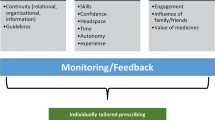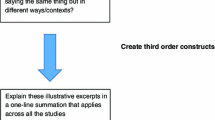Abstract
Background
Polypharmacy, common in elderly multimorbid adults, leads to increased iatrogenic health risks. Yet, no consistent approach to stopping medicines exists in primary healthcare.
Objectives
Our objective was to synthesize qualitative studies exploring the perspectives and experiences of general practitioners (GPs) and older patients in reducing polypharmacy and to discover approaches already being practiced.
Methods
We conducted a search in the PubMed, Cochrane Library, Web of Science Core Collection, and Scopus databases to identify qualitative studies in the primary care setting addressing multimorbid older patients and polypharmacy reduction. The seven-step model of meta-ethnography allowed for cross-interpretation between studies considering their original context and developing theories.
Results
A total of 14 studies from the perspectives of patients (n = 6) and providers (n = 8) were included, although discontinuing medicines only occurred as a sub-theme in patient studies. Emerging key concepts for patients were experimenting with medicines, attitudes and experiences towards medicines, necessity of prioritizing treatments, relationship to GP, and system-related contributors. For GPs, they covered assumptions about elderly patients, interface prescribing problems, evidence-based guidelines, failure to meet the challenge of complex decision-making, and solutions.
Discussion
Complex medication regimens and uncertainties in decision making are challenges for both GPs and patients. For patients, symptom experiences with medicines, relationship with their prescriber, and fragmented care are at the forefront; for GPs, it is the decision-making responsibility in the context of unsuitable guidelines, time constraints, and deficient multidisciplinary co-operation. Heuristics such as prioritizing and individualizing treatments and relaxation of guidelines emerged. These strategies require professional awareness of the problem and establishing a trusting, patient-centered consultation style and supportive work conditions.

Similar content being viewed by others
References
Haefeli WE. Polypharmazie. Swiss Med Forum. 2011;47:847–52.
Neuner-Jehle S. Weniger ist mehr–wie Polypharmazie vermeiden? Praxis. 2013;102:21–7.
Viniol A, Bösner S, Baum E, et al. Forgotten drugs: long-term prescriptions of thyroid hormones – a cross sectional study. Int J Gen Med. 2013;6:329–34.
Keller H, Hirsch O, Kaufmann-Kolle P, et al. Evaluating an implementation strategy in cardiovascular prevention to improve prescribing of statins in Germany: an intention to treat analysis. BMC Public Health. 2013;13:623.
Deveugele M, Derese A, van den Brink-Muinen A, et al. Consulting length in general practice: cross sectional study in six European countries. BMJ. 2002;325:472.
Burkhardt H, Wehling M. Probleme bei der Pharmakotherapie älterer Menschen. Der Internist. 2010;51:737–48.
Moynihan R, Henry D. The fight against disease mongering: Generating knowledge for action. PLoS Med. 2006;3:e191.
Gnjidic D, Le Couteur DG, Kouladjian L, et al. Deprescribing trials: methods to reduce polypharmacy and the impact on prescribing and clinical outcomes. Clin Geriatr Med. 2012;28:237–53.
Hajjar ER, Cafiero AC, Hanlon JT. Polypharmacy in elderly patients. Am J Geriatr Pharmacother. 2007;5:345–51.
Rottenkolber D, Schmiedl S, Rottenkolber M, et al. Adverse drug reactions in Germany: direct costs of internal medicine hospitalizations. Pharmacoepidemiol Drug Saf. 2011;20:626–34.
Steinman MA, Landefeld CS, Rosenthal GE, et al. Polypharmacy and prescribing quality in older people. JAGS. 2006;54:1516–23.
Junius-Walker U, Theile G, Hummers-Pradier E. Prevalence and predictors of polypharmacy among older primary care patients in Germany. Fam Pract. 2007;24:14–9.
Frazier SC. Health outcomes and polypharmacy in elderly individuals: an integrated literature review. J Gerontol Nurs. 2005;31:4–11.
Budnitz DS, Lovegrove MC, Shehab N, et al. Emergency hospitalizations for adverse drug events in older Americans. N Engl J Med. 2011;365:2002–12.
Alldred DP. Deprescribing: a brave new word? Int J Pharm Pract. 2014;22:2–3.
de Vries ThP, Henning RH, Hogerzeil HV, et al. Guide to good prescribing. Geneva: World Health Organization; 1995.
Woodward MC. Deprescribing: achieving better health outcomes for older people through reducing medications. J Pharm Pract Res. 2003;33:323–8.
Scott IA, Gray LD, Martin JH, et al. Deciding when to stop: towards evidence-based deprescribing of drugs in older populations. Evid Based Med. 2013;18:121–4.
Scott IA, Gray LD, Martin JH, et al. Minimizing inappropriate medications in older populations: a 10-step conceptual framework. Am J Med. 2012;125:529–37.
Scott IA, Anderson K, Freeman CR, et al. First do no harm: a real need to describe in older patients. Med J Aust. 2014;201:390–2.
Scott IA, Le Couteur DG. Physicians need to take the lead in deprescribing. Int Med J. 2015;45:352–6.
Scott IA, Hilmer SN, Reeve E, et al. Reducing inappropriate polypharmacy. The process of deprescribing. JAMA. Intern Med. 2015;175:827–34.
Campanelli CM. American Geriatrics Society 2015 Updated Beers Criteria for Potentially Inappropriate Medication Use in Older Adults: The American Geriatrics Society 2015 Beers Criteria Update Expert Panel. J Am Geriatr Soc. 2012;60:616–31.
Holt S, Schmiedl S, Thürmann PA. Potentially inappropriate medications in the elderly: the PRISCUS list. Dtsch Arztebl Int. 2010;107:543–51.
O’Mahony D, O’Sullivan D, Byrne S, et al. STOPP/START criteria for potentially inappropriate prescribing in older people: version 2. Age Ageing. 2015;44:213–8.
Wehling M. Drug therapy in the elderly: too much or too little, what to do? A new assessment system: fit for the aged (FORTA). Dtsch Med Wochenschr. 2008;133:2289–91.
Leitliniengruppe Hessen. Hausärztliche Leitlinie Multimedikation. Empfehlung zum Umgang mit Multimedikation bei Erwachsenen und geriatrischen Patienten. http://www.pmvforschungsgruppe.de/pdf/03_publikationen/multimedikation_II.pdf. Accessed 10 Feb 2014.
Garfinkel D, Mangin D. Feasibility study of a systematic approach for discontinuation of multiple medications in older adults. Arch Intern Med. 2010;170:1648–54.
Hanlon JT, Schmader KE, Samsa GP, et al. A method for assessing drug therapy appropriateness. J Clin Epidemiol. 1992;45:1045–51.
Hausärztliche Leitlinie: Multimedikation als “iatrogene” Erkrankung—und wie man ihr begegnet. http://deutsch.medscape.com/artikelansicht/4904080#vp_2. Accessed 15 Dec 2015.
Noblit GW, Hare RD. Meta-ethnography: synthesizing qualitative studies. Newbury Park: Sage; 1988.
Britten N, Campbell R, Pope C, et al. Using meta-ethnography to synthesise qualitative research: a worked example. J Health Serv Res Policy. 2002;7:209–15.
Campbell R, Pound P, Morgan M, et al. Evaluating meta-ethnography: systematic analysis and synthesis of qualitative research. Health Technol Assess. 2011;15:1–164.
Tong A, Sainsbury P, Craig J. Consolidated criteria for reporting qualitative research (COREQ): a 32-item checklist for interviews and focus groups. Int J Qual Health Care. 2007;9:349–57.
Campbell R, Pound P, Pope C, et al. Evaluating meta-ethnography: a synthesis of qualitative research on lay experiences of diabetes and diabetes care. Soc Sci Med. 2003;56:671–84.
Tordoff J, Simonsen K, Thomson WM, et al. „It’s just routine”. A qualitative study of medicine taking amongst older adults in New Zealand. Pharm World Sci. 2010;32:154–61.
Torrible SJ, Hogan DB. Medication use and rural seniors. Who really knows what they are taking? Can Fam Physician. 1997;43:893–8.
Gröber-Grätz D, Waldmann UM, Metzinger U, et al. Reasons of changes in drug therapy after hospital discharge: a qualitative study of perception by general practitioners and patients. Gesundheitswesen. 2014;76:639–44.
Krska J, Morecroft CW, Poole H, et al. Issues potentially affecting quality of life arising from long-term medicines use: a qualitative study. Int J Clin Pharm. 2013;35:1161–9.
Linsky A, Simon SR, Bokhour B. Patient perceptions of proactive medication discontinuation. Patient Educ Couns. 2015;98:220–5.
Post SG, Stuckey JC, Whitehouse PJ, et al. A focus group on cognition-enhancing medications in Alzheimer disease: disparities between professionals and consumers. Alzheimer Dis Assoc Disord. 2001;15:80–8.
Unson CG, Siccion E, Gaztambide J, et al. Nonadherence and osteoporosis treatment preferences of older women: a qualitative study. J Womens Health (Larchmt). 2003;12:1037–45.
Givens JL, Datto CJ, Ruckdeschel K, et al. Older patients’ aversion to antidepressants: a qualitative study. J Gen Intern Med. 2006;21:146–51.
Harrold LR, Mazor KM, Veltens S, et al. Patients and providers view gout differently: a qualitative study. Chronic Illn. 2010;6:263–71.
Spinewine A, Swine C, Dhillon S, et al. Appropriateness of use of medicines in elderly inpatients: qualitative study. BMJ. 2005;3331:935.
Yegenoglu S, Baydar T. Information and observation of community pharmacists on geriatric patients: a qualitative study in Ankara City. Turk J Geriatr. 2011;14:344–51.
Farrell B, Tsang C, Raman-Wilms L, et al. What are priorities for deprescribing for elderly patients? Capturing the voice of practitioners: a modified Delphi process. PLoS One. 2015;10:e0122246.
Schuling J, Gebben H, Veehof LJ, et al. Deprescribing medication in very elderly patients with multimorbidity: the view of Dutch GPs. A qualitative study. BMC Fam Pract. 2012;13:56.
Herrmann ML, von Waldegg GH, Kip M, et al. GP Medication prioritisation in older patients with multiple comorbidities recently discharged from hospital: a case-based bottom-up approach. Gesundheitswesen. 2015;77:16–23.
Elliott RA, Ross-Degnan D, Adams AS, et al. Strategies for coping in a complex world: adherence behavior among older adults with chronic illness. J Gen Intern Med. 2007;22:805–10.
Bagge M, Tordoff J, Norris P, et al. Older people’s attitudes towards their regular medicines. J Prim Health Care. 2013;5:234–42.
Meranius MS, Hammar LM. How does the healthcare system affect medication self-management among older adults with multimorbidity? Scand J Caring Sci. 2015. doi:10.1111/scs.12225.
Moen J, Bohma A, Tillenius T, et al. ‘‘I don’t know how many of these [medicines] are necessary’: a focus group study among elderly users of multiple medicines. Patient Educ Couns. 2009;74:135–41.
Marx G, Püsche K, Ahrens D, et al. Polypharmacy: a dilemma in primary care? Results of group discussions with general practitioners. Gesundheitswesen. 2009;71:339–48.
Moen J, Norrgård S, Antonov K, et al. GPs’ perceptions of multiple-medicine use in older patients. J Eval Clin Pract. 2010;16:69–75.
Anthierens S, Tansens A, Petrovic M, et al. Qualitative insights into general practitioners views on polypharmacy. BMC Fam Pract. 2010;11:65.
Sinnott C, McHugh SM, Boyce MB, et al. What to give the patient who has everything? A qualitative study of prescribing for multimorbidity in primary care. Br J Gen Pract. 2015;65:e184–91.
Smith SM, O’Kelly S, O’Dowd T. GPs’ and pharmacists’ experiences of managing multimorbidity: a ‘Pandora’s box’. Br J Gen Pract. 2010;60:285–94.
Fried TR, McGraw S, Agostini JV, et al. Views of older persons with multiple morbidities on competing outcomes and clinical decision-making. J Am Geriatr Soc. 2008;56:1839–44.
Berne E. Principles of transactional analysis. Indian J Psychiat. 1996;38:154–9.
Anderson K, Stowasser D, Freeman C, et al. Prescriber barriers and enablers to minimizing potentially inappropriate medications in adults: a systematic review and thematic synthesis. BMJ Open. 2014;4:e006544.
Cullinan S, O’Mahony D, Fleming A, et al. A meta-synthesis of potentially inappropriate prescribing in older patients. Drugs Aging. 2014;31:631–8.
Sinnott C, McHugh S, Browne J, et al. GPs’ perspectives on the management of patients with multimorbidity: systematic review and synthesis of qualitative research. BMJ Open. 2013;3:e003610.
Reeve E, To J, Hendrix I, et al. Patient barriers to and enablers of deprescribing: a systematic review. Drugs Aging. 2013;30:793–807.
Reeve E, Shakib S, Hendrix I, et al. Review of deprescribing processes and development of an evidence-based, patient-centred deprescribing process. Br J Clin Pharmacol. 2014;78:738–47.
Neuner-Jehle S, Krones T, Senn O. Systematic deprescribing of medicaments is accepted and feasible among polymorbid family medicine patients. Praxis. 2014;103:317–22.
Cooper JA, Cadogan CA, Patterson SM, et al. Interventions to improve the appropriate use of polypharmacy in older people: a Cochrane systematic review. BMJ Open. 2015;5:e009235.
Scottish Government Model of Care Polypharmacy Working Group. Polypharmacy Guidance. 2nd ed. Scottish Government; 2015.
Author information
Authors and Affiliations
Corresponding author
Ethics declarations
Funding
No sources of funding were used to assist in the preparation of this article.
Conflicts of interest
Beate Bokhof and Ulrike Junius-Walker declare that they have no conflicts of interest relevant to the content of this review.
Electronic supplementary material
Below is the link to the electronic supplementary material.
Rights and permissions
About this article
Cite this article
Bokhof, B., Junius-Walker, U. Reducing Polypharmacy from the Perspectives of General Practitioners and Older Patients: A Synthesis of Qualitative Studies. Drugs Aging 33, 249–266 (2016). https://doi.org/10.1007/s40266-016-0354-5
Published:
Issue Date:
DOI: https://doi.org/10.1007/s40266-016-0354-5




